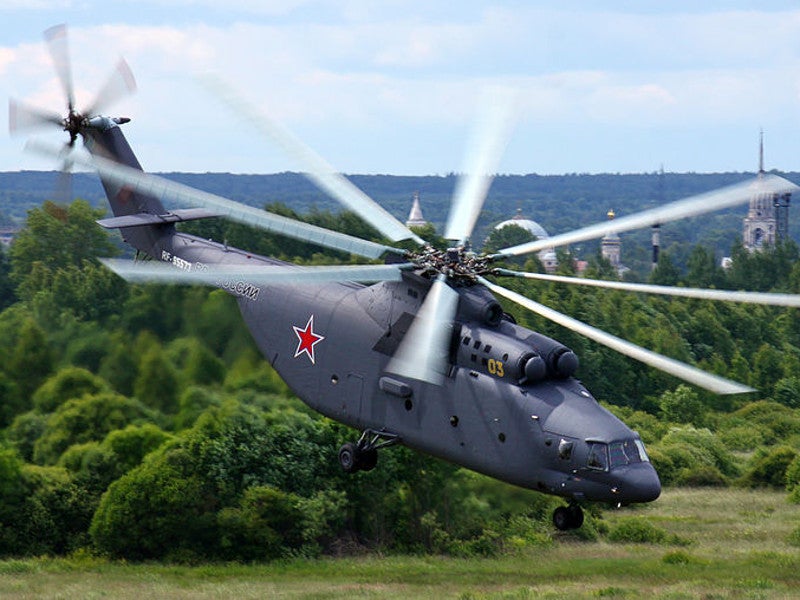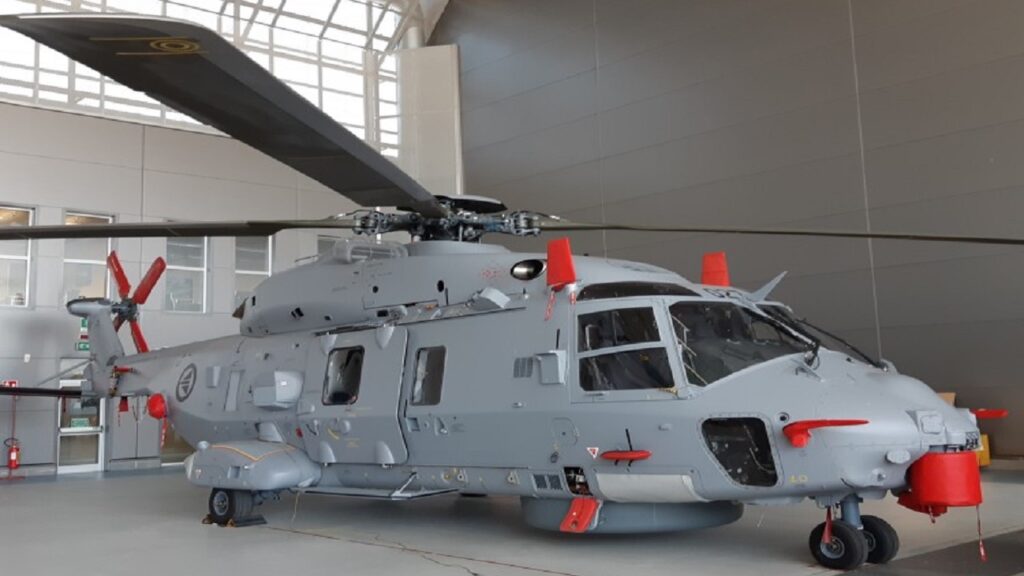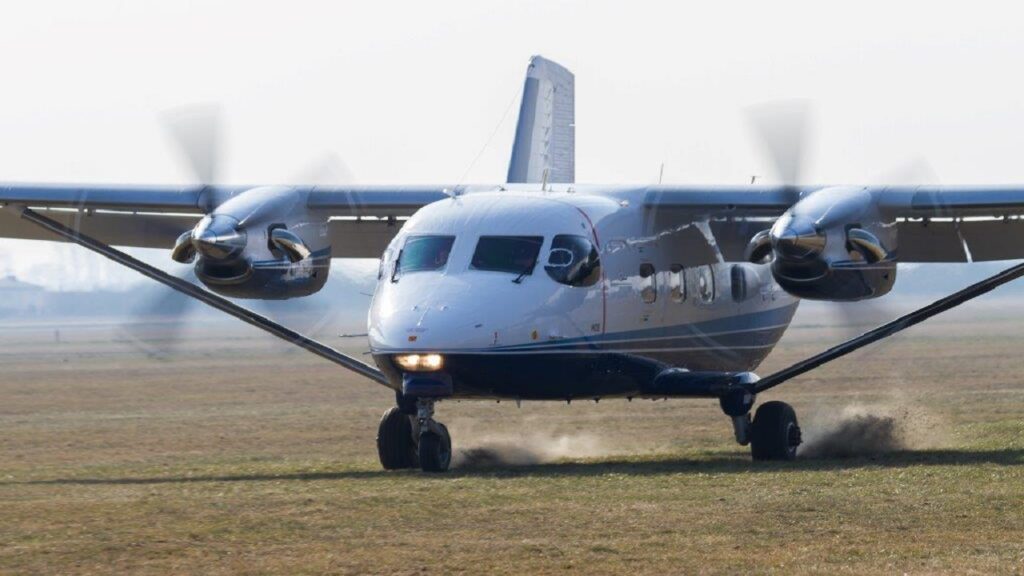
The Mil Mi-26 is a twin-engine heavy transport helicopter designed and manufactured by Mil Moscow Helicopter Plant, Russia, for both military and civilian roles. It is the second largest and powerful helicopter in the world, and entered into service in 1985.
The helicopter’s maiden flight took place in December 1977. About 316 Mi-26 helicopters were produced until 2015.
Mi-26 helicopter variants
Mi-26 has 13 variants of Mi-26A, Mi-26M, Mi-26MS, Mi-26NEF-M, Mi-26P, Mi-26PP, Mi-26PK, Mi-26S, Mi-26T, Mi-26TP, Mi-26TS, Mi-26TZ and Mi-27.
The Mi-26A is an advanced version of the Mi-26 and completed its flight test in 1985. It is upgraded with a structured PNK-90 flight navigation system for automated approach and decline.
Another variant, the Mi-26M is an upgraded version of Mi-26. It is incorporated with a flight navigation system, D-127 turboshaft engines, an electronic flight instrumentation system and aerodynamic rotor blades for better performance.
The Mi-26T is a commercial cargo or freight transport version. It was first showcased in the 1997 Moscow Air Show. The helicopter was later displayed at Farnborough Air Show held in 2002 after installing advanced avionics by Rostvertol.
Mi-26MS is an upgraded model of the Mi-26T. The variant is a medical evacuation helicopter and comprises intensive care section for four casualties and two medics, ambulance section for five stretcher patients, three seated casualties and two attendants, and a laboratory.
The Mi-26NEF-M is another variant of Mi-26 fitted with a search radar below the nose radome. It is an anti-submarine warfare version boasting heat exchangers and towed MAD housing fitted on a ramp.
The Mi-26P is a passenger transport version, which can carry 70 to 100 passengers. The variant features airline-type seating, with a centre aisle, bathroom, kitchen and cloakroom near the flight deck.
Another variant, the Mi-26PP, is a radio relayed version with its first flight test completed in 1986. The Mi-26PK is derived from the Mi-26P. It is a flying crane helicopter introduced in 1997. The Mi-26S is a disaster relief version incorporated with a discharging liquid tank and underbelly spraying apparatus.
The Mi-26TP is a fire-fighting helicopter, which can distribute 17,260l of water from a squat VSU-15 bucket. It was first introduced in 1994.
Another variant, the Mi-26TS, is an export version of the Mi-26T supplied to Samsung Aerospace Industries, South Korea.
The Mi-26TZ is a fuel tanker version, while the Mi-27 is airborne command post variant.
Mi-26 orders and deliveries
The Indian Air Force (IAF) ordered six Mi-26 helicopters, the first two of which, worth INR180m ($3.86m), were delivered in June 1986. The third and fourth were delivered to IAF in February 1989 at a cost of INR220.7m ($4.73m).
The remaining two, however, were cancelled due to reduced utilisation of the aircraft. The IAF has also procured 12 engines.
Apart from Russia, it is in service in Ukraine, Kazakhstan, Belarus, India, Peru, Greece, Laos, Cyprus, North Korea, South Korea, Malaysia, Mexico and Venezuela.
Mi-26 heavy lift helicopter design
The Mi-26 is designed to increase flight safety and reliability. It also reduces the workload of the flight crew, the mission planning time and the total operational cost. It is designed to replace its earlier version Mi-6 and Mi-12 helicopters.
The Mi-26 can perform a number of tasks, including the transferring of military equipment, namely personnel carriers and mobile ballistic missiles, to distant locations.
Composite material used in the fuselage design reduces the overall weight of the helicopter. The alloys used in the fuselage construction are 26% lighter than aluminium alloys earlier used in the Mi-6 helicopter.
Mi-26 development
The development of the Mi-26 began in early 1970. The empty weight of the developed aircraft is half of its maximum take-off weight. Its payload capacity is 1.5 to two times more than earlier versions.
The first Mi-26 was rolled out in October 1980. The prototype helicopter was first showcased in the 1981 Paris Air Show. Following the completion of the Mi-26’s development in 1983, it entered into service in 1985.
Rostvertol is currently producing Mi-26 helicopters that can operate efficiently both day and night in adverse weather conditions and water basins. The helicopter is also used in the construction of bridges and power transmission lines.
Mi-26 features
Mi-26 features eight main rotor blades and five tail rotor blades fitted above the mid-fuselage section on hump. The heavy load carrying capacity and high cruise speed feature allow the helicopter to be economically efficient.
The helicopter also comprises a cargo compartment on the rear side of the cockpit. The compartment, which is 12m long, 3.3m wide and 3.2m high, can hold two combat vehicles of approximately 1,000kg each. Two electric winches on the overhead rails are used to move loads into the cabin. It also boasts a closed-circuit television camera to monitor the positioning of slung load.
The Mi-26 boasts electrically de-iced main and tail rotor blades, infrared jammers, infrared suppressors, infrared decoy dispensers and a colour-coded identification flare system to protect the helicopter from ballistic missiles. Infrared jammers block the infrared signal transmission and protect the helicopter from infrared missiles.
Mi-26 cockpit
The cockpit, pressurised to optimise visibility, accommodates five flight crew, namely the pilot, co-pilot, flight engineer, navigator and electronic radio operator. The seats of the pilot and co-pilot are located adjacent to each other in the front side of the cockpit control panel. The flight engineer and navigator seats are built on the back side of the pilot’s seat.
Mi-26 avionics
The helicopter is equipped with a Groza 7A813 weather radar, an integrated PKV-26-1 flight navigation system, an automatic flight control system, a Doppler, map display, horizontal situation indicator (HSI), an automatic hover system and a global positioning system (GPS).
Mi-26 landing gear
Mi-26 features non-retractable tricycle-type landing gear with two steerable nose wheels. The hydraulic crane allows for the cargo loading of different surfaces through rear doors (tail fuselage) using ladders and sub ladders. The take-off weight can be displayed in the sensor or electronic device fitted on the main gear’s shelf on the rear side of the flight engineer seat.
Lotarev D-136 engines
Mi-26 is powered by two Lotarev D-136 turboshaft engines. Each engine can produce 8,380kW of power. The synchronisation of outputs between the two engines maintains a constant rotor rpm.
The second engine’s output will be increased to maximum power when the first engine fails as to complete the task efficiently.
Each engine bay is manufactured with titanium to safeguard against fire. The maximum internal fuel capacity of each tank is 12,000l.
Mi-26 aircraft performance
The Mi-26 can fly at a maximum speed of 295km/h and a cruise speed of 255km/h. The range and service ceiling of the helicopter is 1,952km and 4,600m respectively, while its hover ceiling is 1,700m. The helicopter weighs around 28,200kg and its maximum take-off weight is 56,000kg.



